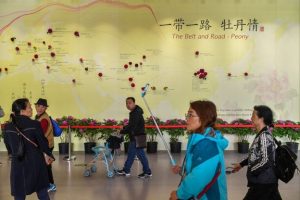
Investments in public health projects by China’s Belt and Road Initiative soared by 246 per cent last year in response to the Covid-19 pandemic, according to a Chinese study. The dramatic shift in focus for President Xi Jinping’s pet global infrastructure plan has come at the expense of other sectors, with overall finance and investments steady – at US$59 billion in 2021, compared to US$60.5 billion the previous year.
Analysis by the Green Finance and Development Centre at Shanghai’s Fudan University found belt and road investments in health sector construction rose in the same period from US$130 million in 202o to US$450 million. Projects included Burkina Faso’s University Hospital in Bobo-Dioulasso by Beijing Urban Construction Group, according to the report’s author Christoph Nedopil Wang, founding director of the centre.
The report said total belt and road engagement last year was split between US$13.9 billion in investments and US$45.6 billion in contracts, partly financed by Chinese loans. Wang also found no coal projects in the belt and road data for 2021 – in line with Xi’s pledge that China would no longer fund overseas coal-fired plants. Green energy finance and investment edged up to US$6.3 billion, compared with US$6.2 billion in 2020, according to the report.
Since its inception in 2013, the belt and road initiative has mainly focused on public infrastructure projects linking Asia, Europe and Africa in a modern-day Silk Road. A total of 144 countries are involved in the plan. As Covid-19 spread across the globe, some of the initiative’s flagship projects were delayed by labour and raw material shortages as governments imposed travel restrictions and stringent border controls. But the surge in public health investments has also been fuelled by official calls for more belt and road involvement in the sector, as China aims to cement its role as a leader in the world’s pandemic response. Foreign Minister Wang Yi said in 2020 that global efforts to contain the pandemic should be coordinated and promised that China would develop “a healthy Silk Road”.
The National Development and Reform Commission, which oversees belt and road projects, said in November the programme had shown full resilience during the pandemic, as more countries joined its health cooperation efforts. Doron Ella, a postdoctoral fellow at the Leonard Davis Institute for International Relations at Hebrew University, analysed data from the Asian Infrastructure Investment Bank (AIIB) and found a similar switch to public health financing and projects to improve its members’ economic resilience.
The Beijing-led AIIB – which funds infrastructure and public works in Asia – went from zero such projects on its books in 2019 to half of its portfolio in 2020, he found. Public health and economic resilience funding by the AIIB fell last year, but still accounted for a quarter of its investments. “There is the obvious reason that the pandemic has created a public health crisis which exposed countries’ – and especially developing countries’ – underinvestment in their public health capacities, [including] infrastructure, technologies, pharmaceuticals and equipment,” Ella said.
“Additionally, the pandemic is causing an economic crisis which is set to harm developing countries the most,” he added, noting that other multilateral development banks – such as the Asian Development Bank and the World Bank – had also expanded their coverage of these areas.
“The AIIB – as an international financial institution that also thinks about how it can make profits so it can continue its operations without significant costs – saw this health and economic crisis as an opportunity to expand its operations,” Ella said.
“By expanding its scope, China is able to gain more legitimacy for the bank – which is shunned by the US and Japan – and show that it is flexible and able to respond to ongoing international crises.”
According to Ella, the bank’s financing scheme includes supplies of many public health-related products and equipment, as well as vaccines, by Chinese companies.
In the Fudan University report, Wang identified another big shift in the belt and road plan’s focus – with investments in the Middle East and Africa rising last year by about 360 per cent.
Top recipient in 2021 was Iraq, which received US$10.5 billion in financing for infrastructure projects, including the Al-Khairat heavy oil power plant in Karbala province.
China’s Sinopec won the contract to develop Iraq’s Mansuriya gas field near the Iranian border. China and Iraq are also cooperating on an airport, solar power and other projects.
“While there is clearly a big need for investment and construction in countries of the Middle East and Africa, some of these contracts might depend on strong local government support, as well as guarantees of the underlying natural resources,” Wang said.
“Many Asian countries are not endowed with such possibilities at this time, making Middle Eastern and African countries more attractive for such type of engagement.”
This article was retrieved from: https://www.scmp.com/news/china/diplomacy/article/3165950/chinas-belt-and-road-funding-pivot-pumps-millions-public (11 February 2022)